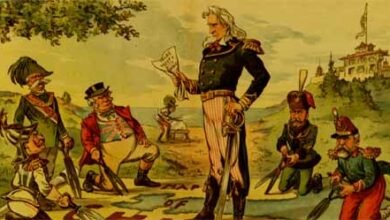
भौतिकी विज्ञान से संबंधित-98.
| 1. Sun appears red while rising and setting, because? = Red color has the least scattering.
2. The imaginary line which falls on the circular mirror passing through the focus and pole is called? = Main Axis. 3. If the focus of an object falls on a concave mirror, how will its shadow be formed? = Infinite. 4. Two plane mirrors are inclined at an angle of 60° to each other. What will be the number of images formed of a ball placed between them? = 05. 5. A person suffering from farsightedness? = Nearby objects are not visible. 6. Which lens is used in the glasses of a person suffering from farsightedness? = Convex Lens. 7. Which lens is used in the glasses of a person suffering from nearsightedness? = Concave Lens. 8. The size of letters appears smaller with a lens, than the lens? = Concave Lens. 9. What is the unit of power of a lens? = Diopters. 10. A man is standing on a moving stool with his arms outstretched and suddenly shrugs his arms, then the angular velocity of the stool? = Increase. 11. When a body opposes any change in the state of rest or uniform motion in a straight line, it is called? = Inertia. 12. Which unit has the same quantity in all systems? = Specific Gravity. 13. The fluctuation in the frequency of a sound source is called? = Doppler Effect. 14. The number of vibrations a particle makes in one second is called? = Frequency. 15. Which law is related to the statement that a liquid passes equal pressure in all directions? = Pascal’s Law. 16. What principle does the ball pen work? = Surface Tension. 17. The reason for the spherical shape of water droplets? = Surface Tension. 18. What principle is the heat pair thermometer based on? = Seebeck’s Effects. 19. The motion of a body around a circular path is an example of a? = Same Velocity, Variable Acceleration. 20. What is the ability to do work called? = Power. 21. What is the splitting of white light into different colors called? = Deflection. 22. What principle does Periscope work? = Due to Reflection and Refraction. 23. When ice cubes are pressed together, the pieces stick together because? = The melting point of ice decreases with higher pressure. 24. What will be the maximum speed of sound? = Steel. 25. What is used as the core in an electromagnet? = Soft Iron. 26. What is used to measure high temperature? = Pyrometer. 27. Where is the atomic pile used? = Operations of Nuclear Fission. 28. Where do stars get their energy? = Nuclear Fusion. 29. The product of the mass of an object and its velocity is called? = Momentum. 30. When the momentum is doubled, the kinetic energy becomes? = Four Times. ============ ============ =========== 1. उगते व डूबते समय सूर्य लाल प्रतीत होता है, क्योंकि? = लाल रंग का प्रकीर्णन सबसे कम होता है. 2. वह काल्पनिक रेखा जो फ़ोकस एवं पोल से गुजरते हुए गोलकार दर्पण पर पड़ती है, वह कहलाती है? = मुख्य अक्ष. 3. अगर किसी वस्तु का फ़ोकस अवतल दर्पण पर पड़ता है, तो उसकी छाया कैसी बनेगी? = अनन्त. 4. दो समतल दर्पण एक-दूसरे से 60° के कोण पर झुके हैं। इनके बीच रखी एक गेंद के बने प्रतिबिम्बों की संख्या कितनी होगी? = 05. 5. दूर दृष्टिदोष से पीड़ित व्यक्ति को? = निकट की वस्तुएँ दिखाई नहीं देती. 6. दूर दृष्टिदोष से पीड़ित व्यक्ति के चश्मे में कौन-सा लेंस प्रयोग किया जाता है? = उत्तल लेंस. 7. निकट दृष्टिदोष से पीड़ित व्यक्ति के चश्मे में कौन-सा लेंस प्रयोग किया जाता है? = अवतल लेंस. 8. यदि किसी लेंस से अक्षरों का आकार छोटा दिखाई देता हैं, तो लेंस? = अवतल लेंस. 9. लेंस की क्षमता का मात्रक क्या है? = डायोप्टर. 10. एक व्यक्ति घूमते हुए स्टूल पर बांहें फैलाये खड़ा है और अचानक अपनी बांहें सिकोड़ लेता है, तो स्टूल का कोणीय वेग? = बढ़ जायेगा. 11. जब कोई पिण्ड सीधी रेखा में विराम या एकसमान गति की स्थिति में किसी भी परिवर्तन का विरोध करता है उसे कहते हैं? = जड़त्व. 12. समस्त व्यवस्थाओं में किस इकाई की मात्रा समान होती है? = विशिष्ट गुरुत्व. 13. किसी ध्वनि स्रोत की आवृत्ति में होने वाले उतार-चढ़ाव को कहते हैं? = डाप्लर प्रभाव. 14. कोई कण एक सेकेण्ड में जितने कम्पन करता है, उस संख्या को कहते हैं? = आवृति. 15. द्रव सभी दिशाओं में समान दाब पारित करता है, यह कथन किस नियम से सम्बंधित है? = पास्कल का नियम. 16. बाल पेन किस सिद्धांत पर काम करता है? = पृष्ठीय तनाव. 17. पानी की बूंदों के गोल होने का कारण? = पृष्ठीय तनाव. 18. ताप युग्म तापमापी किस सिद्धांत पर आधारित है? = सीबेक के प्रभाव. 19. वृत्ताकार पथ के चारों ओर पिंड की गति किसका उदाहरण है? = समान वेग, परिवर्ती त्वरण. 20. कार्य करने की क्षमता को क्या कहते हैं? = शक्ति. 21. श्वेत प्रकाश को विभिन्न रंगों में विभाजित होना क्या कहलाता है? = विक्षेपण. 22. पेरिस्कोप किस सिद्धांत पर कार्य करता है? = परावर्तन और अपवर्तन के कारण. 23. बर्फ़ के टुकड़ों को आपस में दबाने पर टुकड़े आपस में चिपक जाते हैं, क्योंकि? = दाब अधिक होने से बर्फ़ का गलनांक घट जाता है. 24. ध्वनि की चाल सबसे अधिक होगी? = इस्पात. 25. विद्युत चुम्बक में क्रोड के रूप में किसका इस्तेमाल होता है? = मृदु लोहा. 26. उच्च तापमान नापने के लिए किसे प्रयोग में लाया जाता है? = पायरोमीटर. 27. परमाणु पाइल का प्रयोग कहां होता है? = नाभिकीय विखंडन के प्रचालन 28. तारे अपनी ऊर्जा कहां से प्राप्त करते हैं? = नाभिकीय संलयन 29. किसी वस्तु के द्रव्यमान और उसके वेग के गुणनफल को कहते हैं? = संवेग. 30. संवेग दुगना होने पर गतिज ऊर्जा हो जाती है? = चार गुना.
|





